3.7 How to resolve database load errors
|
| < Day Day Up > |
|
Each and every time you load the contents of a partitioned data set (or an online resource) into the database, you must review the results. The question you must answer is: How well did WSAA process the information you gave it?
3.7.1 Database status problem summary pages
The Database status page has two suboptions, each with their own problem summary reports:
-
Information
-
Errors and warnings
We describe a little bit more about the significance of the information on these pages in the following sections.
Database status - Information
As you know from 1.3, “A quick walking tour” on page 12, the Database status - Information page provides a general overview about the status of ongoing inventory collection requests and presents a list of possible problems to check from completed scans.
After an inventory collection batch job completes, review the following categories:
-
Components not referenced
-
Potential problem areas
Components not referenced
The Components not referenced category includes links to the following database components:
-
JCL members
-
Online data stores
-
Programs
-
Run units
-
Source include files
WSAA lists these items because they appear to be unused; that does not necessarily mean they are unused. These components might be obsolete, or you might simply need to scan more components into the database to resolve the missing relationship.
| Important: | Always review this list of components with your Change Management or Quality Assurance manager. Do not automatically assume that you can simply delete these components because there are no other links. |
If, in fact, a component in a production source library is truly obsolete, perform whatever procedure your site has to delete obsolete components from production before you delete the component’s entry from the database.
Potential problem areas
The Potential problem areas category includes links to the following database components:
-
CICS file resources or IMS database resources without an associated data set:
These links are to online resource names that cannot be connected to a physical data set name.
-
Members of the same name and language in multiple libraries:
These members can cause problems for WSAA during a scan and later when relationships are built among components. You can also get inconsistent results when you attempt to perform a search on a name (when more than one component has that name).
Note We recommend that you review the order of the libraries in your concatenation sets if you find a significant number of entries in this link.
We demonstrate how this issue can be identified and resolved in 3.7.2, “The results of our example loads” on page 97.
-
Program data stores without an associated DD statement and program data stores without an associated online data store:
These are sources that refer to I/O activity that cannot be associated with persistent storage. Two possible causes are as follows:
-
The source is not connected to a run unit.
-
WSAA could not find the connection for the resource name to the data.
-
For example, you may have a batch job that executes a given program in one step. In the program, there is a file definition for a specific file. However, the DD name referred to in the source cannot be found within the job stream. When WSAA cannot connect the DD name to a physical data set name, that component will be listed here.
| Note | You may find, as you load more data into the database, that subtle coding errors or possible coding “shortcuts” have been used in your site’s application portfolio. |
Review this information with your Quality Assurance manager to ensure the appropriate restrictions (or constraints) are implemented. Contact your Change Management manager to develop the appropriate method to remediate any errant code.
Database status - Errors and warnings
The Database status - Errors and warning page lets you determine if the inventory you collected is ready for your site’s application development teams, or if you need to correct any errors. This page shows error, warning, and informational messages that reflect what WSAA encountered while it collected your inventory.
Click any of the numbered links to view the corresponding problem summary report for that topic.
| Note | If you ignore these messages, it is likely that the components in error will not be included when your application development project managers try to analyze the impact of a change. |
If components with informational messages are left out of the analysis, it might not matter. However, if components with error or warning messages are left out of the analysis, the results would be highly suspect, and (more than likely) incomplete.
After the inventory collection batch job completes, review the following categories:
-
Components with syntax errors
-
Missing components
-
Members with analysis anomalies
-
Components with missing or ambiguous parts
Components with syntax errors
The Components with syntax errors category includes links to the following database components:
-
Batch jobs
-
Programs
Syntax errors in both of these cases can be attributed to:
-
Obsolete or invalid source
-
Incorrect concatenation set
-
Incorrect analysis parameters
-
Unsupported syntax
Review and correct any issues associated with the analysis concatenation sets or analysis parameters.
| Note | If you cannot determine how to correct a language syntax error, contact WSAA Support for assistance. |
Missing components
You can use the list of components in this category in conjunction with the Information page’s Components not referenced to help identify additional components that still need to be scanned into the database.
You may find that some of the components are actually located in data sets that you did not identify in your data set checklist. Alternatively, some components may not be located in production data sets. If the latter is the case, make certain to notify your Change Management manager to determine the best approach to include these components into the appropriate production library.
Members with analysis anomalies
This category shows you some of the potential inconsistencies in the members of your production source data sets.
-
Unrecognized language:
Language errors involve syntax that WSAA does not recognize as one of the supported source languages (COBOL, PL/I, JCL, BMS maps, or Assembler).
-
Unrecognized type:
The component’s type is used to trigger the secondary scan. There are specific criteria that the parser uses to determine known types. If the contents of a component do not match the criteria, the scan stops and the component type is marked UNK.
Review each of these entries to see if there is some way in which you can resolve the error. In all likelihood, there will always be some components left in this category.
Components with missing or ambiguous parts
This category is an extension of the Missing components category. It shows you additional areas of concern in terms of run units and their constituent parts. Some of these errors are caused by:
-
Obsolete source
-
Source that has yet to be scanned
-
CICS or IMS components that have not been scanned
Stale projects are projects in which some of the source has been rescanned, but not all of the source that is represented in the project.
Some of the Run units with missing source are likely to be common vendor utility programs that are not known to WSAA. In 3.10.3, “Add system-level programs to the mix” on page 111 we describe the steps to take to include these programs.
3.7.2 The results of our example loads
We were able to successfully load our copybooks. We then loaded our other subordinate components, and then our JCL. Only after we loaded our source did we encounter errors that are worth describing in detail.
On the Database status - Errors and warnings page, when you click Programs under the heading, Components with syntax errors, the Programs with syntax errors window opens, as shown in Figure 3-25.

Figure 3-25: Programs with syntax errors list
Here, you have two choices to find the programs with which you want to work:
-
Scroll through the list to identify the program.
-
Explore the library that you just loaded.
In this case, we know that we are looking for errors with the COBOL source components we just loaded, so we chose the latter option.
| Note | If we didn’t share the DemoMVS system with any other groups, this would not be necessary. |
To show the appropriate page, perform the following steps:
-
Click Explore -> MVS assets -> Library.
-
Type DNET998* in the Search field and click the Go button.
The Library summary page with the DNET998 data sets is displayed, as shown in Figure 3-26.
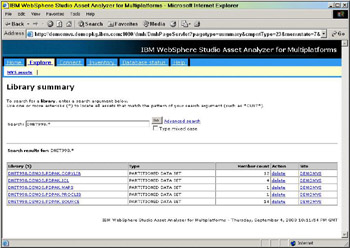
Figure 3-26: Library summary page of DNET998 data sets -
Click DNET998.PDPAK.DEMOS.SOURCE to display the Library details page, as shown in Figure 3-27.
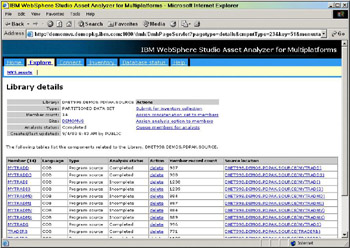
Figure 3-27: Library details page of source data set with inventory collection errorsAs you can see, there are several programs whose Analysis status is “Incomplete.”
Review them one at a time to determine why they have this status and what can be done to correct it.
-
Click the first member with an error, MYTRADI, to display the Member details page, as shown in Figure 3-28.

Figure 3-28: Member details page with analysis error messagesUnder the heading, Analysis messages for member MYTRADI, we see the following text:
TYPE=13 Identify Analysis Concatenation Set - waiting for the user to identify copy or include search path.
It appears that WSAA was somewhat confused as to which DLIUIB member to use to complete the program’s analysis.
| Note | This is significant, because the WSAA will only make simple assumptions about which member should be included. In all other cases, you must provide the appropriate solution. |
Recall the information we presented in Chapter 1. You should be able to search for a component on your own to make sure you know which one to specify.
| Tip | One quick way to find a component is to open another instance of your Web browser (in Internet Explorer, File -> New -> Window) and search for it from the WSAA Home page. |
When we searched for DLIUIB, we found four different versions in the DemoMVS system, as shown in Figure 3-29.
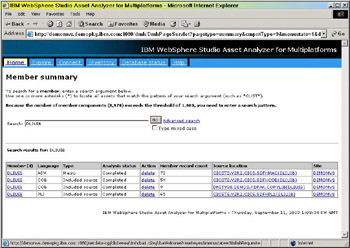
Figure 3-29: Member summary page showing search results for DLIUIB
WSAA knows that the member is in one of the DNET998 data sets. We simply have to tell it to explicitly use that data set.
If this was the only program with an error, you could click Identify analysis concatenation set, under the Actions heading, to assign the appropriate concatenation set. However, there are other programs with errors. You must first review each one to see if there is any pattern to the errors.
Sure enough, each program needs to have the appropriate concatenation set assigned to it. The easiest way to do this is from the Library summary page.
-
Click Assign concatenation set to members, under the Actions heading. The Assign concatenation set to library members page is displayed, as shown in Figure 3-30.
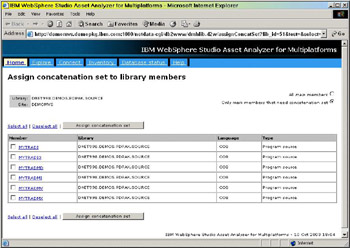
Figure 3-30: Assign concatenation set to library members pageNotice that the radio button, Only main members that need concatenation set, has been selected. WSAA is smart enough to recognize the appropriate subset of the entire library; however, you have the ability to select all main members, if you so desire.
-
Click Select all to select all of the members.
-
Click the Assign concatenation set button. The Assigning concatenation set page is displayed, as shown in Figure 3-31.

Figure 3-31: Assigning concatenation set page with the desired entry selected -
Scroll through the list until you find the appropriate concatenation set and click the Submit button. The Job submission page is displayed.
-
If necessary, edit the JCL in the job card, otherwise, click Submit the job in background.
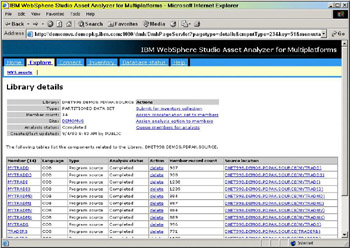
Figure 3-32: Library details page after the assignment of concatenation set
Now that inventory collection of one of your data sets is complete, and you have corrected all of the errors associated with it, you can continue to load the contents of the rest of your site’s application portfolio.
| Note | If you find your programs listed in the Errors and warnings page, but find that the Analysis status is “Completed” when you view the member details, please be aware that there is a glitch in the product that will list Maps as “Incomplete” even though they are, in fact, completely scanned. |
WSAA Support is aware of this problem and (at the time of this writing) is attempting to correct the problem.
After you complete your inventory collection, you can begin to explore the contents of your database. See Chapter 4, “Exploring your inventory” on page 115 for more information.
|
| < Day Day Up > |
|
EAN: 2147483647
Pages: 84